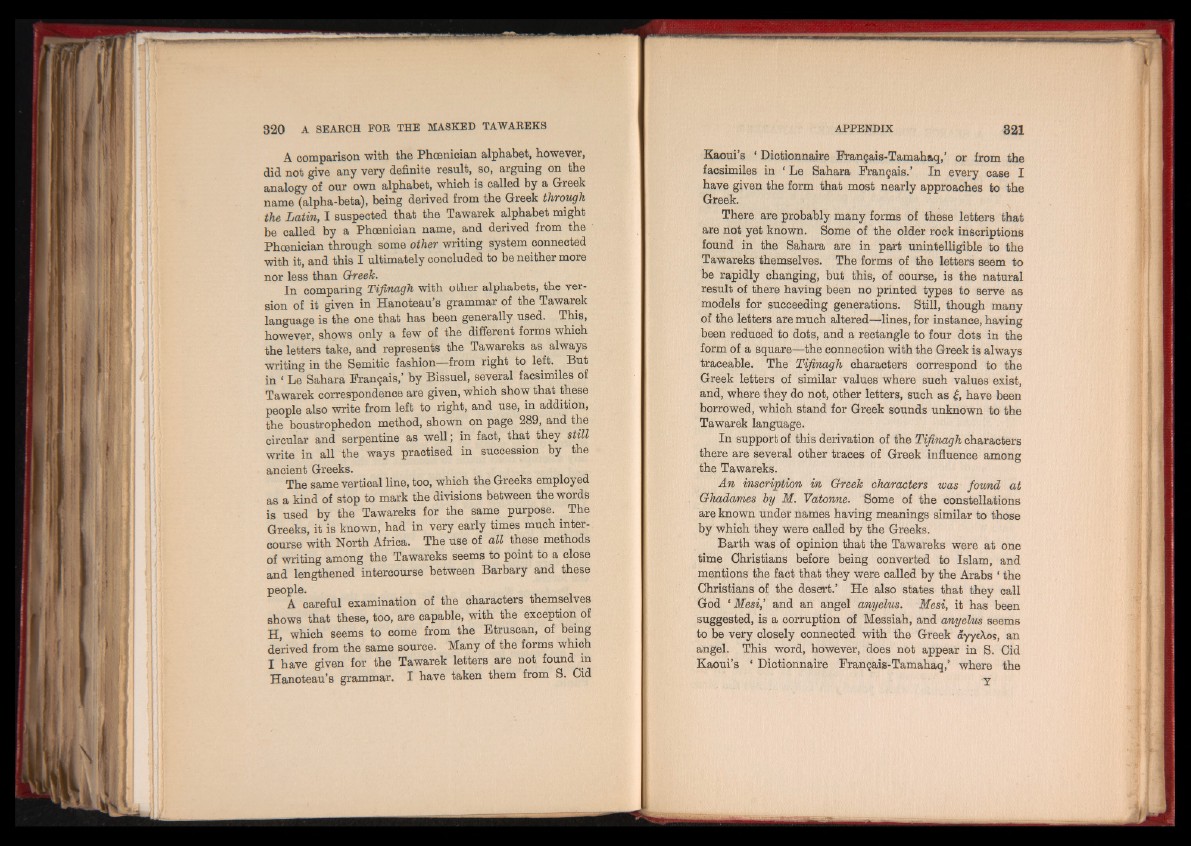
A comparison with the Phoenician alphabet, however,
did not give any very definite result, so, arguing on the
analogy of our own alphabet, which is called by a Greek
name (alpha-beta), being derived from the Greek through
the Latin, I suspected that the Tawarek alphabet might
be called by a Phoenician name, and derived from the
Phoenician through some other writing system connected
with it, and this I ultimately concluded to be neither more
nor less than Greek.
In comparing Tifinagh with other alphabets, the version
of it given in Hanoteau’s grammar of the Tawarek
language is the one that has been generally used. This,
however, shows only a few of the different forms which
the letters take, and represents the Tawareks as always
writing in the Semitic fashion—from right to left. But
in ‘ Le Sahara Français,’ by Bissuel, several facsimiles of
Tawarek correspondence are given, which show that these
people also write from left to right, and use, in addition,
the boustrophedon method, shown on page 289, and the
circular and serpentine as well; in fact, that they still
write in all the ways practised in succession by the
ancient Greeks.
The same vertical line, too, which the Greeks employed
as a kind of stop to mark the divisions between the words
is used by the Tawareks for the same purpose. The
Greeks, it is known, had in very early times much intercourse
with North Africa. The use of all these methods
of writing among the Tawareks seems to point to a close
and lengthened intercourse between Barbary and these
people.
A careful examination of the characters themselves
shows that these, too, are capable, with the exception of
H, which seems to come from the Etruscan, of being
derived from the same source. Many of the forms which
I have given for the Tawarek letters are not found in
Hanoteau’s grammar. I have taken them from S. Gid
Kaoui’s ‘ Dictionnaire Français-Tamah&q,’ or from the
facsimiles in * Le Sahara Français.’ In every case I
have given the form that most nearly approaches to the
Greek.
There are probably many forms of these letters that
are not yet known. Some of the older rock inscriptions
found in the Sahara are in part unintelligible to the
Tawareks themselves. The forms of the letters seem to
be rapidly changing, but this, of course, is the natural
result of there having been no printed types to serve as
models for succeeding generations. Still, though many
of the letters are much altered—lines, for instance, haying
been reduced to dots, and a rectangle to four dots in the
form of a square—the connection with the Greek is always
traceable. The Tifinagh characters correspond to the
Greek letters of similar values where such values exist,
and, where they do not, other letters, such as have been
borrowed, which stand for Greek sounds unknown to the
Tawarek language.
In support of this derivation of the Tifinagh characters
there are several other traces of Greek influence among
the Tawareks.
An inscription in Greek characters was found at
Ghadames by M. Vatonne. Some of the constellations
are known under names having meanings similar to those
by which they were called by the Greeks.
Barth was of opinion that the Tawareks were at one
time Christians before being converted to Islam, and
mentions the fact that they were called by the Arabs * the
Christians of the desert.’ He also states that they call
God ‘ Mesi,’ and an angel anyelus. Mesi, it has been
suggested, is a corruption of Messiah, and anyelus seems
to be very closely connected with the Greek oyyeAos, an
angel. This word, however, does not appear in S. Cid
Kaoui’s ‘ Dictionnaire Français-Tamahaq,’ where the
Y